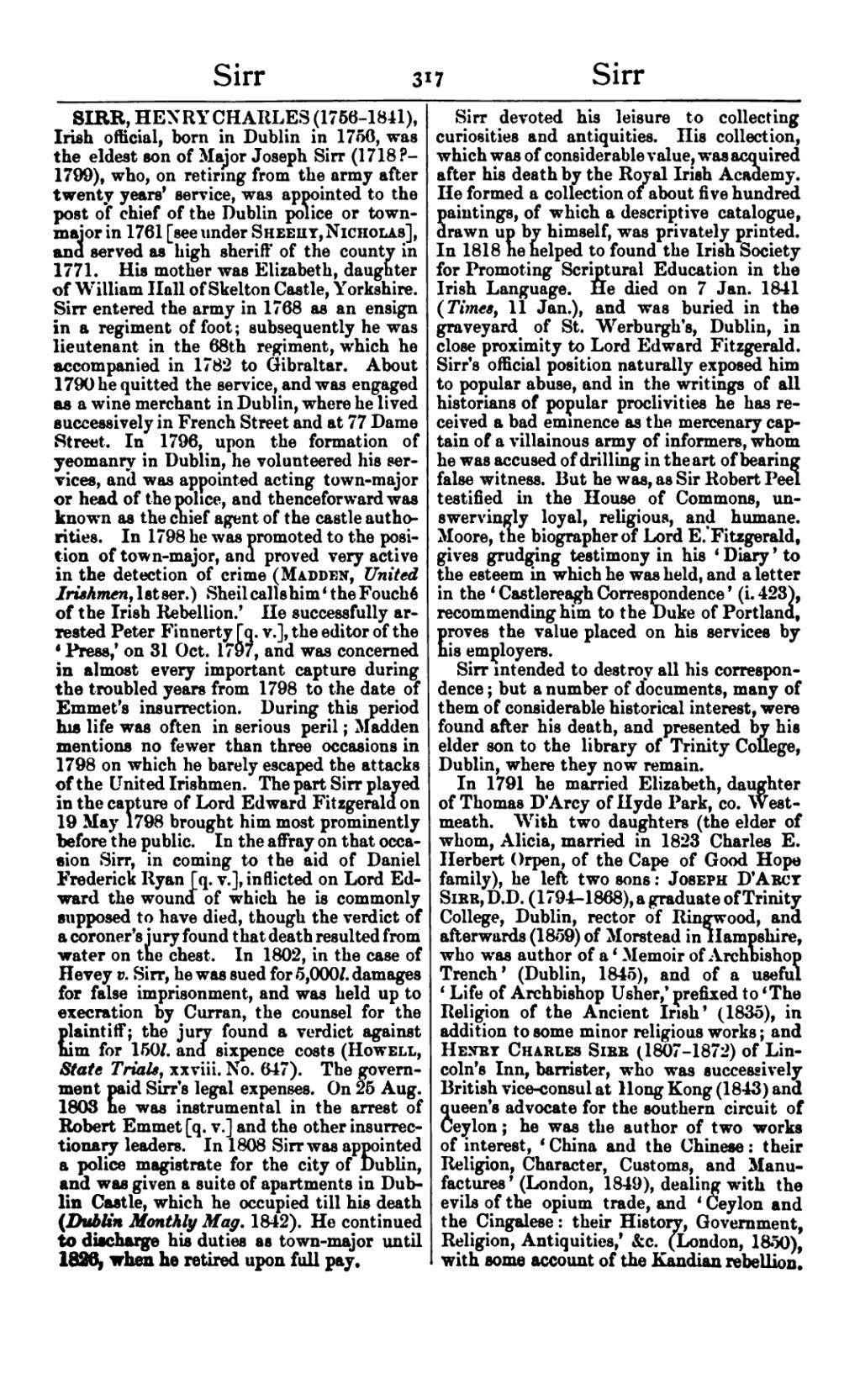SIRR, HENRY CHARLES (1764–1841), Irish official, born in Dublin Castle on 25 Nov. 1764, was fifth, but eldest surviving son of Major Joseph Sirr (1715–1799), who, on retiring from the army after twenty years' service, was appointed to the post of chief of the Dublin police or town-major in 1761 [see under Sheehy, Nicholas], and served as high sheriff of the county in 1771. His mother was Elizabeth, daughter of William Hall of Skelton Castle, Yorkshire. Sirr entered the army 6 June 1778 as an ensign in 68th regiment of foot; subsequently he was lieutenant in the 68th regiment, which he accompanied in 1782 to Gibraltar. In 1791 he quitted the service, and was engaged as a wine merchant in Dublin, where he lived successively in French Street and at 77 Dame Street. In 1796, upon the formation of yeomanry in Dublin, he volunteered his services, and was appointed acting town-major or head of the police, and thenceforward was known as the chief agent of the castle authorities. In 1798 he was promoted to the position of town-major, and received, in accordance with precedent, a residence in Dublin Castle. He proved very active in the detection of crime (Madden, United Irishmen, 1st ser.). Sheil calls him ‘the Fouché of the Irish Rebellion.’ He successfully arrested Peter Finnerty [q. v.], the editor of the ‘Press,’ on 31 Oct. 1797, and was concerned in almost every important capture during the troubled years from 1798 to the date of Emmet's insurrection. During this period his life was often in serious peril; Madden mentions no fewer than three occasions in 1798 on which he barely escaped the attacks of the United Irishmen. The part Sirr played in the capture of Lord Edward Fitzgerald on 19 May 1798 brought him most prominently before the public. In the affray on that occasion Sirr, in coming to the aid of Daniel Frederick Ryan [q. v.], inflicted on Lord Edward the wound of which he is commonly supposed to have died, though the verdict of a coroner's jury found that death resulted from water on the chest. In 1802, in the case of Hevey v. Sirr, he was sued for 5,000l. damages for false imprisonment, and was held up to execration by Curran, the counsel for the plaintiff; the jury found a verdict against him for 150l. and sixpence costs (Howell, State Trials, xxviii. No. 647). The government paid Sirr's legal expenses. On 25 Aug. 1803 he was instrumental in the arrest of Robert Emmet [q. v.] and the other insurrectionary leaders. In 1808 Sirr was appointed a police magistrate for the city of Dublin. He continued to discharge his duties as town-major until 1826, when he retired upon full pay, and in consideration of his public services was allowed to retain his official residence in Dublin Castle.
Sirr devoted his leisure to collecting curiosities and antiquities. His collection, which was of considerable value, was acquired after his death by the Royal Irish Academy. He formed a collection of about five hundred paintings, of which a descriptive catalogue, drawn up by Joseph D'Arcy Sirr and by Mr. George Norman D'Arcy, was privately printed. In 1818 he helped to found the Irish Society for Promoting Scriptural Education in the Irish Language. He died on 7 Jan. 1841 (Times, 11 Jan.), and was buried in the graveyard of St. Werburgh's, Dublin, in close proximity to Lord Edward Fitzgerald. Sirr's official position naturally exposed him to popular abuse, and in the writings of all historians of popular proclivities he has received a bad eminence as the mercenary captain of a villainous army of informers, whom he was accused of drilling in the art of bearing false witness. But he was, as Sir Robert Peel testified in the House of Commons, unswervingly loyal, religious, and humane (23 May and 26 June 1823; cf. Hansard, n. s. ix. 468, 1309). Moore, the biographer of Lord E. Fitzgerald, gives grudging testimony in his ‘Diary’ to the esteem in which he was held, and a letter in the ‘Castlereagh Correspondence’ (i. 423), recommending him to the Duke of Portland, proves the value placed on his services by his employers.
Sirr intended to destroy all his correspondence; but a number of documents, many of them of considerable historical interest, were found after his death, and presented by his elder son to the library of Trinity College, Dublin, where they now remain.
In 1791 he married Elizabeth, daughter of James D'Arcy of Hyde Park, co. Westmeath. With two daughters (the elder of whom, Alicia, married in 1823 Charles E. Herbert Orpen, of the Cape of Good Hope family), he left two sons: Joseph D'Arcy Sirr, D.D. (1794–1868), a graduate of Trinity College, Dublin, rector of Ringwood, and afterwards (1859) of Morstead in Hampshire, who was author of a ‘Memoir of Power le Poer Trench, last archbishop of Tuam’ (Dublin, 1845, 8vo), of ‘Sacrifices, Past, Present, and Future’ (1862, 12mo), and of a useful ‘Life of Archbishop Usher,’ prefixed to ‘The Religion of the Ancient Irish’ (1835), in addition to some minor religious works; and Henry Charles Sirr (1807–1872) of Lincoln's Inn, barrister, who was successively British vice-consul at Hong Kong (1843) and queen's advocate for the southern circuit of Ceylon; he was the author of two works of interest, ‘China and the Chinese: their Religion, Character, Customs, and Manufactures’ (London, 1849), dealing with the evils of the opium trade, and ‘Ceylon and the Cingalese: their History, Government, Religion, Antiquities,’ &c. (London, 1850), with some account of the Kandian rebellion.

